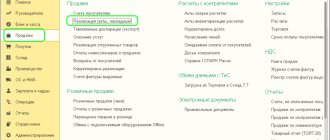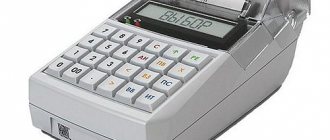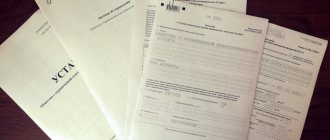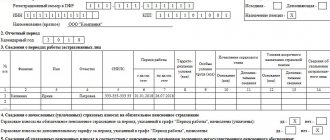What is primary documentation in accounting?
An example of a “primary document” in accounting is any document confirming transactions of a taxpayer. We are talking about transactions that are related to the economic activities of the organization and make economic sense.
All primary accounting documentation is described in Federal Law No. 402-FZ “On Accounting”. Documents must be collected and executed in accordance with this law in order to confirm expenses and prove to the Federal Tax Service the correctness of the calculation of the tax base.
The primary document must be drawn up at the time of the business transaction, since the document confirms its completion. Typically this is done by the supplier. The list of primary accounting documentation accompanying the transaction depends on the type of transaction and may differ. You need to be especially careful about the documents for transactions in which you are the buyer, since these are your expenses and you are more interested in the correct execution of documents than the supplier. The tax office may not credit the “primary” with errors.
Details
Client Responsibilities
Financial institutions that issue loans oblige clients to deposit funds strictly within the established time frame. Delays in payments lead to the accrual of penalties. Rarely, for example, if there is a system failure, payment may be delayed (or fail). In this case, the payer must prove that the payment was made in order to avoid repeated payment.
Proof of payment in credit institutions is considered a payment receipt, order or account statement. When depositing money into the client’s personal account, the operator issues a cash receipt order, which indicates information about the payer (full name), the name of the financial institution, as well as the date of the transaction and the amount deposited. At the bottom of the order, confirming signatures of the participants in the transaction (client, cashier and manager) are placed; most often, the form is certified by the seal of the organization.
What is an Extract
A statement is a document that represents a list of transactions on the payer’s account.
The statement may indicate one or several banking transactions recorded for a certain period of time (for example, for a specific month), information about the owner (full name), name of the organization and account number, date of issue of the statement and information about the authorized person. It is also possible to print out an electronic document when making a payment through UCO (remote service channels) - this could be a terminal, online banking, or a mobile version of the site. A check is issued when paying a debt to the account of a legal entity. It indicates the details of the recipient, the name of the organization, information about the payer, the amount, date of payment and its purpose. The check printed after the transaction is completed is a reporting document confirming payment. If the client does not have a check, he can contact the bank with a request to restore it. If the transaction is carried out by the client himself, for example, through a terminal or in an online bank, an employee of a financial institution can reprint an account statement or make a copy of a check.
In case of loss of documents
... made on paper, their recovery period can be up to 30 days. To speed up the search for a transaction, the payer must indicate the exact date and time when the payment took place, as well as the recipient’s details. If such information is not available, the bank may refuse to issue a duplicate document. If the payment took place more than 6 months ago, you will need to request information through the archive. This service is performed no earlier than three days. A fee may be paid for the restoration of certificates.
Tax payments are the responsibility of every Russian citizen. Payments for property, transport, and land are provided annually. If there is no confirmation of payment, then in addition to the accrual of penalties, this may result in a ban on leaving the country.
For the Federal Tax Service, documents confirming payment are:
- check,
- receipt order,
— an extract from the client’s account, certified by the signature of an authorized person and seal,
- another document that proves the payment transaction has been completed (for example, a bank form indicating that the debt has been repaid).
When paying debts, the payer has the right and obligation to request a document confirming payment. The bank can refuse to issue a check only if the client requests several checks at once. In accordance with the Tax Code of the Russian Federation, financial organizations can issue original certificates. Duplicates are issued as an exception after a written statement from the client about the loss of the check is issued.
Managers of an organization may refuse to issue a certificate for third parties in the absence of a notarized power of attorney authorizing the issuance of documents in the name of the payer.
In case the payment was made from a bank plastic card account
...using the SMS notification service, the payer receives a confirmation code on his phone, after which he enters the amount and the money is sent to the specified account. Confirmation of payment, in this case, is an SMS about the sending and completion of the transaction or a statement about the status of the bank card account.
In case of filing a claim or complaint with Rospotrebnadzor
…the customer must provide proof of the transaction. The court needs documentary evidence of the transaction with all the necessary information about the payer, the amount of payment and its date. To do this, you will need to provide the original check or order. In addition, from a financial institution you can obtain a certificate confirming the banking transaction and certified by the signature of an authorized person and the seal of the bank. If the payment was made online, it is better to print out the receipt in a timely manner and have it certified at the branch where the account is maintained.
Orders are stored in the archives of financial organizations for 5 years. Housing and communal services may require proof of payments from clients within 3 years from the date of payment. In accordance with the law, the storage period for evidentiary documents confirming payment is 5 years. The advantage of paying online is the ability to print receipts for 10 years or more.
Storage of primary documents
The primary product must be stored for at least 5 years. During this period, the Federal Tax Service may request documents from you or your counterparties at any day in order to conduct an inspection. Documents will also be needed in case of legal disputes.
Previously, storing documents required racks, folders and a lot of paper. Now, to free up space in the office and save time and money, transfer the primary archive to electronic form. Accounting services help organize documents and store scans of them in an electronic archive - this makes it easier to search for documents. In the service list, it is easier to track the shortage of primary goods, closure, payment and transaction documents. Electronic documents are certified with an electronic signature.
If a company does not have a primary document whose mandatory storage period has not yet expired, it will receive a fine of 10 to 30 thousand rubles. Another problem with loss of documents is the inability to take into account expenses to calculate the tax base. In this case, the tax office will charge additional tax, and the company will have to pay extra.
Is it possible to accept PKO as an advance report instead of a taxi receipt?
- The Pension Fund of the Russian Federation has approved the rules for obtaining a certificate of pre-retirement status
- How to formalize the limitation of powers of the chief accountant?
- Can a new employee take 28 calendar days of vacation during the first year?
- Do I need to issue a check when receiving non-cash payments from July 1, 2021?
- Insurance period for sick leave
- It is clarified in which case “maternity” and “children’s” benefits need to be transferred to “Mir” cards
- What entrepreneurs should not do: read the latest clarifications from the Ministry of Finance, the Federal Tax Service and court decisions
- Is it necessary to pay compensation for caring for a child under 3 years old in the amount of 50 rubles in 2021?
- Is it possible to hire an employee without a military ID?
- Cancellation of SNILS: how to register employees in the persuet accounting system now?
- Rostrud answered questions related to the provision of vacations
- Why doesn’t 1C 3.0 include vacation pay in the calculation of 6-NDFL?
- When an individual without individual entrepreneur status will have to pay VAT
- How to calculate the salary of an employee who works at 0.75 times the rate?
- Is it possible to provide personal leave and annual leave one after the other?
- Employers will be fined if, through their fault, drivers violate the work and rest schedule
- FSS: “maternity” and “children’s” benefits issued from May 1 should be transferred only to “Mir” cards
- In what account should rent payments be recorded?
- The Supreme Court clarified whether payment of bonuses can relieve employers from the obligation to index wages
- Why in 1C 3.0 does the premium accrued in March not fall into section 1 of the 6-NDFL calculation for the 1st quarter?
>Is a receipt order a confirmation of payment?
Primary documents are divided by business stage
All transactions of the company can be divided into three stages:
The first stage is an agreement on the terms of the transaction . The result will be an agreement and an invoice for payment.
The second stage is payment for the transaction . Primary documents confirming payment:
- Cash payments - cash receipt, receipt for cash receipt order, strict reporting form. Organizations rarely pay each other in cash, since the amount of payments through the cash register is limited to 100 thousand rubles. Employees usually receive advances or accountable money in cash.
- Electronic payments, including acquiring, payment systems or transfers from a current account - bank account statement.
The third stage is receiving products . Confirmation is required that the buyer has received the product or service, and the seller has received payment. Without supporting documents, the tax office will not allow you to include the funds spent in expenses. Receipt is confirmed:
- waybill;
- sales receipt;
- act of work performed or services rendered.
Question
What primary documents can confirm the costs associated with an employee paying registration fees for participation in a scientific conference abroad using a bank card? How to reimburse an employee for the costs of paying registration fees if the employee, with the exception of a bank card extract confirming payment of registration fees, has not provided and cannot provide any other documents (the organization holding the conference does not issue documents for the provision of services)? Income tax? We are talking about an employee’s personal bank card, which can be either wage or non-wage. This question can also be formulated as follows: Employees of the organization participate in Russian and international conferences. Registration fees for participation in conferences are paid with personal bank cards and in cash. 1. Can the University pay registration fees for participation in international conferences from its current account? If so, what is needed for this? 2. Foreign companies holding conferences do not have representative offices in Russia, and the University does not have a foreign currency account. Is it necessary to pay for org. fees for participation in international and Russian conferences to conclude an agreement? 3. What documents must an employee provide to reimburse the fees paid by him from a personal bank card and in cash? 4. What primary documents can confirm the costs associated with an employee’s participation in an international and Russian scientific conference? How to reimburse an employee for the costs of paying registration fees if the employee, with the exception of an extract from a personal bank card confirming payment of registration fees, did not submit any documents confirming participation in the conference (the organization hosting the conference does not issue documents for the provision of services)? 5. In what case should expenses related to an employee’s participation in a conference be included in taxable income?
Primary documentation in accounting list of documents 2020
Transactions vary significantly from company to company. Despite this, there is a list of primary documentation that is required in accounting:
- Agreement.
- An invoice for payment.
- Payment documents: cash receipts, strict reporting forms.
- Packing list.
- Certificate of work performed or services provided.
- Invoice.
This list of transaction documents is not exhaustive; it can expand depending on the types of transactions and accounting features in the organization.
In what cases should CCT be used?
What documents should the UTII payer issue in exchange for a cash receipt?
- Title of the document;
— serial number of the document, date of its issue;
— name of the organization (full name of the entrepreneur);
— TIN of the organization (entrepreneur);
— name and quantity of paid goods purchased (work performed, services rendered);
— the amount of payment made in cash and (or) using a payment card, in rubles;
- position, surname and initials of the person who issued the document, and his personal signature.
Can a UTII payer, accepting cash for household services to the population, not use cash registers and not issue strict reporting forms?
No, he can not.
Until July 1, 2019, the UTII payer may not use cash registers and issue strict reporting forms instead of a cash receipt only if the following conditions are simultaneously met:
Can an entrepreneur with a patent, accepting cash for household services, not use cash registers and not issue strict reporting forms?
No, he can not.
An entrepreneur with a patent has the right until 07/01/2019 not to use cash registers and, instead of a cash receipt, issue strict reporting forms only if the following conditions are simultaneously met:
Formation of primary accounting documentation
The rules for maintaining primary documentation allow for its compilation using independently developed or unified forms (Article 9 No. 402-FZ). But remember that only a document containing all the necessary details has legal force:
- Title of the document.
- Date of creation.
- The name of the organization or the name of the entrepreneur of the compiler.
- Contents of a document or business transaction.
- Natural and monetary indicators.
- Data of responsible persons.
- Signatures of the parties.
The primary forms that the organization uses are fixed in the accounting policies. In the process of work, there may be a need to update or supplement forms - this is also recorded in the accounting policy.
Let's look at the primary documents in more detail.
Agreement
When concluding a transaction, the parties enter into an agreement between themselves, which stipulates all the conditions and details of future business transactions: terms of shipment of goods, performance of work or provision of services, time for payment, payment method, etc.
Additionally, the contract records data on the subject of the transaction and the price. The rights and obligations of the parties also need to be spelled out to make it easier to resolve possible disputes in court.
It is optimal if each transaction is formalized in a separate agreement. But companies often enter into one general agreement with regular counterparties for a number of similar transactions at once. Draw up two copies of the agreement with seals and signatures of the parties on each.
A written form of agreement is not always necessary. For example, for a purchase and sale transaction, the document confirming the conclusion is a cash receipt or sales receipt.
An invoice for payment
An invoice is a document in which the seller sets the price for his services or goods.
The buyer agrees to the supplier's terms and conditions at the time of payment. The legislator does not establish the form of the invoice, so each company draws it up in its own way. The invoice specifies the terms of the transaction, terms, payment and delivery procedures, etc.
The signature of the director or chief accountant on this document is not required (Article 9 No. 402-FZ). But to avoid any questions from the tax authorities or counterparties, it is better not to neglect them. An invoice for payment does not provide an opportunity to present demands to the supplier - it only records the purchase price. The buyer retains the right to demand a refund in case of violation of the terms of the contract or illegal enrichment of the supplier.
Types of documents
There are a large number of payment papers. Their exact list depends on the specific procedure and is clarified by the applicant in advance. Let us consider separately the main types of payment documents, their purpose and rules for filling them out.
Invoice (invoice)
An invoice is a mandatory document that is drawn up by the seller of transported products and handed over to the customer (buyer). It performs the following important functions:
- Confirmation of the fact that the seller has fulfilled the main terms of the transaction (transfer of products that meet all the requirements and characteristics of the purchase and sale agreement).
- Confirmation of payment of value added tax for its further deduction.
The exact list of payment documents depends on the specific transaction.
The document must contain the following information:
- Buyer and seller data.
- Date of registration.
- Number.
- Name and quantity of goods.
- Cost of goods.
- Tax rate.
- Country of origin.
- Amount of value added tax, etc.
Payment order
A payment order is a document that is drawn up by the owner of a bank account (when carrying out foreign trade activities - by the buyer or seller). The paper is necessary to transfer the amount of money specified in it to the account of another subscriber (seller). With the help of a payment order, non-cash payments for delivered goods are carried out.
The paper must contain the details of the recipient and sender of funds, the amount of the transfer, the date of execution and paper number, purpose of payment, etc.
Extract from the personal account
An extract from the buyer’s personal account is required to confirm the transfer of funds and fulfillment of the payment terms of the contract.
You can request a personal statement from the banking organization where the account is registered. A copy of the document is attached to the general package of papers.
Tax receipts
The next required payment documents are tax receipts. Transportation of goods requires payment of customs duties in the established amount. Before submitting a package of papers, you must take the details of the customs authority and pay the tax.
The receipt must necessarily indicate the date of transfer and the amount of tax, details of the payer and recipient, information about the banking organization, purpose of payment, etc.
Bill of lading or sales receipt
Sales receipts are issued in two cases: when selling goods by individuals or when selling to individuals.
Invoices, as a rule, are used by organizations to document the sale of goods and their further receipt by the buyer.
Like the contract, the invoice is drawn up in two copies. One remains with the supplier to confirm the transfer of goods, and the second is received by the buyer to confirm receipt.
The data in the delivery note and invoice must match.
The person who releases the goods puts his personal signature and the company seal on the delivery note. And the buyer also certifies the document with a signature and seal.
Receipt of the intermediary
Checks from mobile banking are more convenient than traditional paper payments. They are always at hand and never fade, and such a receipt can also be printed if necessary. The website of a financial organization popular among compatriots says that a check in electronic form is a full-fledged payment document. But according to the law, this is not entirely true, says Yuri Tverdokhleb, associate professor of the Department of “Regulation of Financial Institutions” at the Faculty of Finance and Banking of the Russian Presidential Academy of National Economy and Public Administration. When you make purchases, the receipt is not issued by the bank, but by the seller. It is printed on a special machine that has a fiscal (tax) memory - this is necessary for the tax service. The main purpose of cash register receipts was originally precisely to keep track of cash. Electronic payments appeared later and began to replace payments with bills and coins. However, the check has fully retained the function of formalizing the contract, and sellers often require them, for example, when applying for a guarantee.
“The document sent by the bank is not a cashier’s check. The bank is an intermediary that only transfers money. The document that you receive after a transaction in a mobile bank is called a “transaction receipt” - it does not contain the details of a cashier’s check, it only indicates the time, amount and recipient of the payment,” explains Stanislav Drobotov, a member of the St. Petersburg Bar Association.
And even a printed check from a mobile bank does not confirm the fact of the transaction, adds lawyer Andrei Kozbanov. After all, modern printing technology makes it possible to create a fake of any receipt without any problems.








